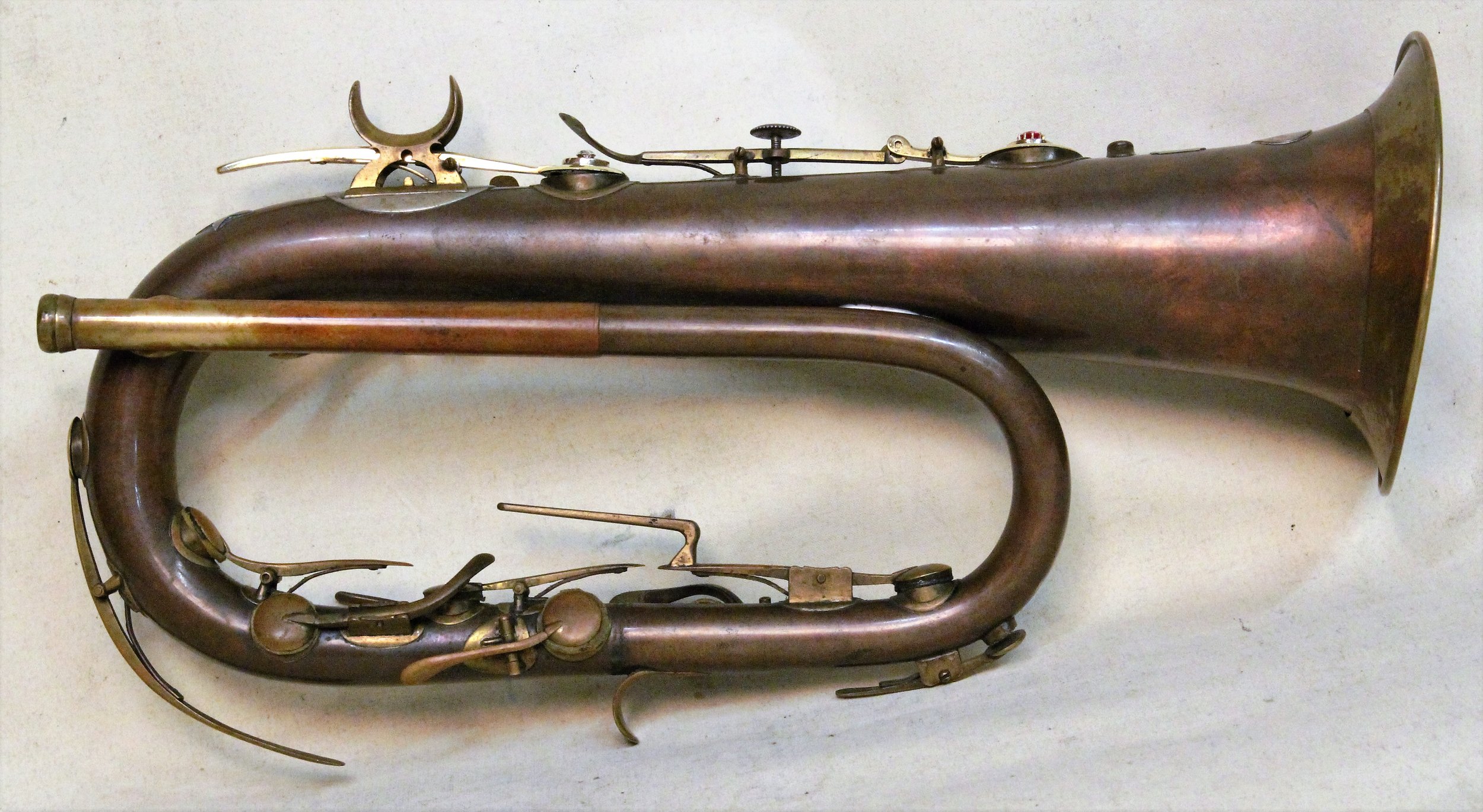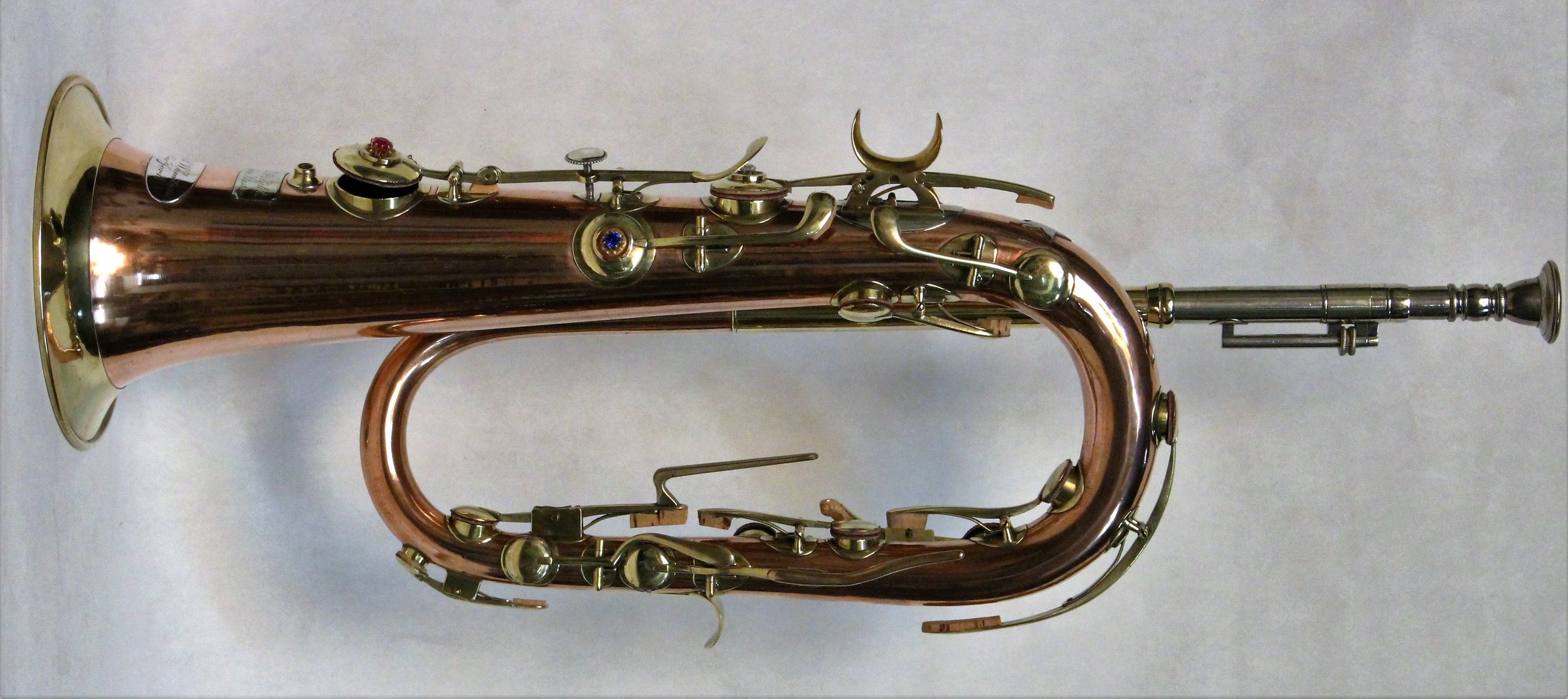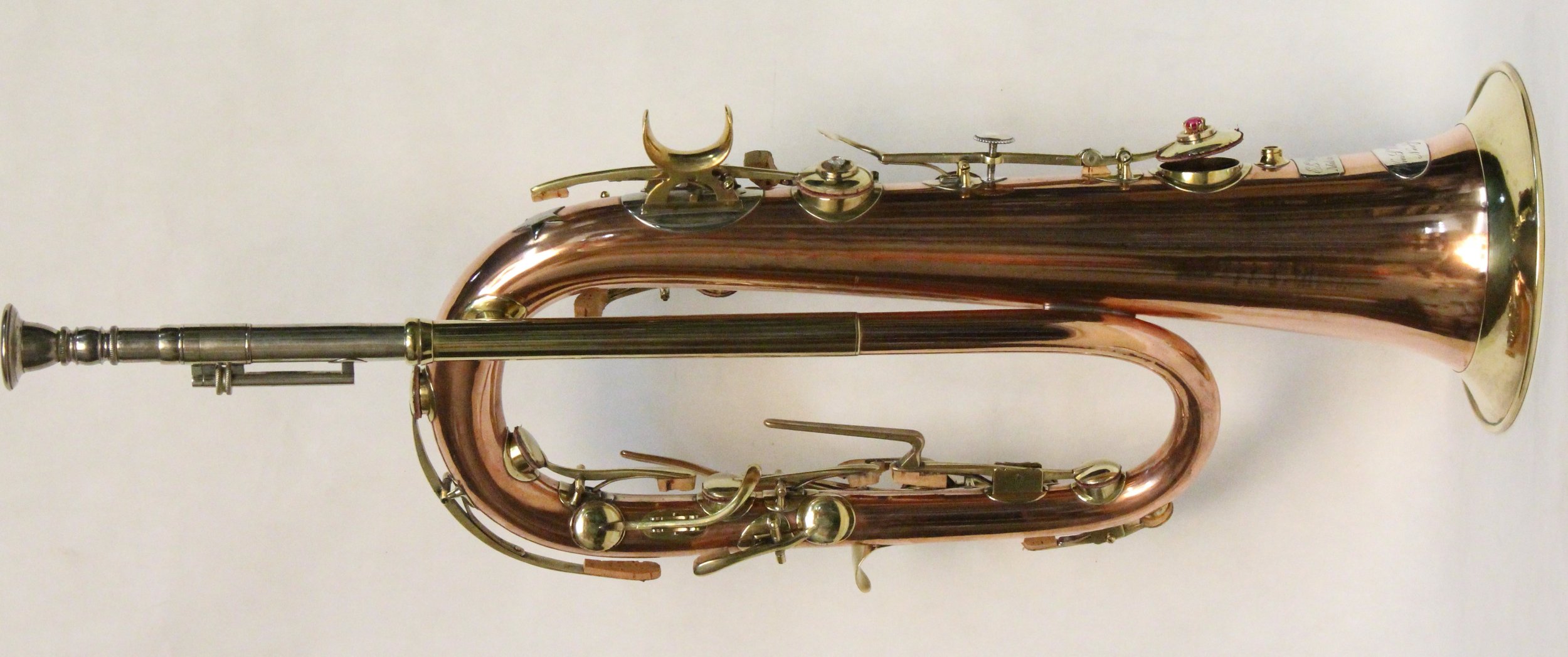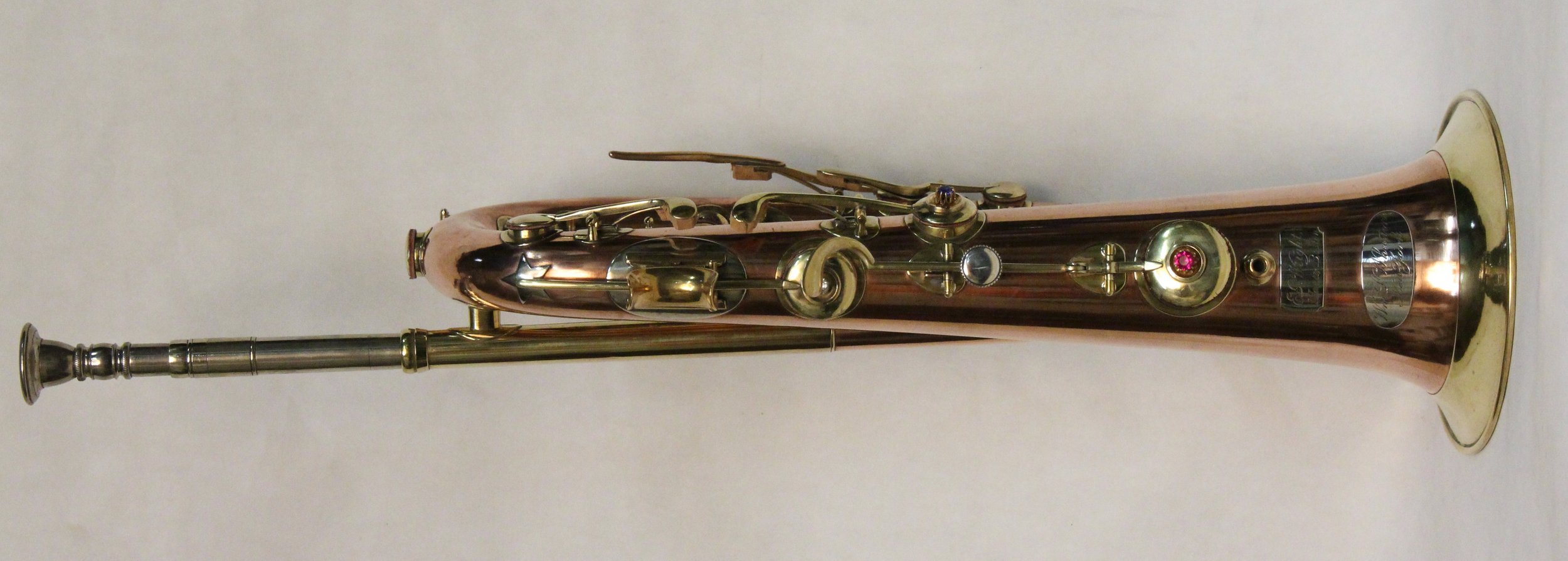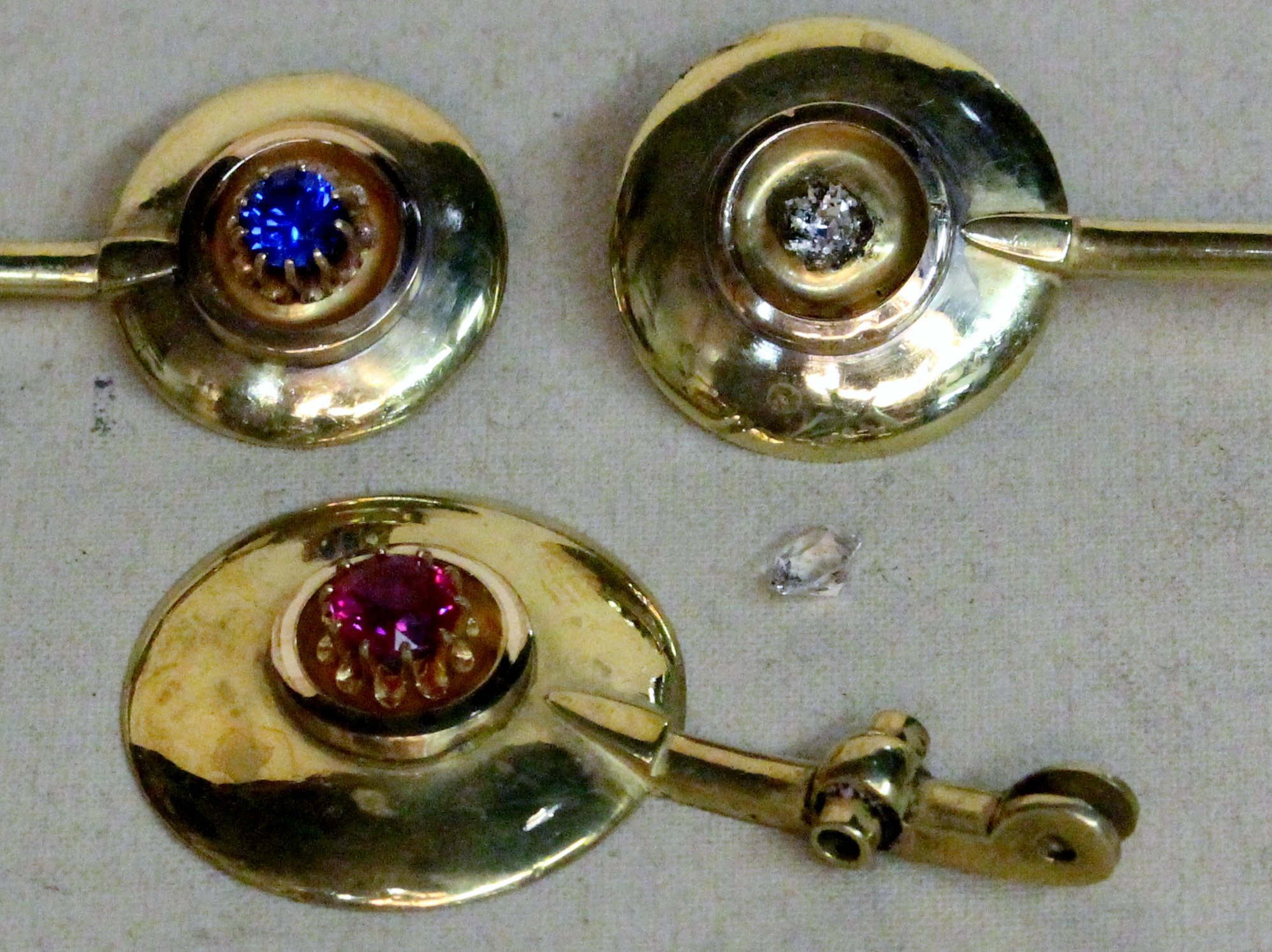Highly Improved Bugle by E.G. Wright
It has long been accepted as fact that Boston maker Elbridge G. Wright developed the keyed bugle as a musical instrument beyond any other maker. The maximum number of keys found on the best of these is normally twelve, but on this bugle we find fourteen. This instrument was most likely made in the 1850s, when Wright was in his prime as a maker.
Among the three dozen or so keyed bugles that I've restored over the years, at least four of them, made by Wright, have been modified or "improved" after they left the maker's shop. This indicates the high expectations that the musician placed on these bugles and, just like todays musicians, were always looking for more. The most commonly seen modification, beyond repair of damage, or replacement of lost parts, is the relocation of tone hole chimneys to improve intonation and applying a patch over the portion of the hole that is exposed.
This one was decorated with a silver name plate, star shaped reinforcement where the E key strikes and three stones mounted on the three largest key cups. The original stones were missing raising speculation that they were precious or semi-precious stones and later re-purposed in jewelry. Colored glass stones, in a patriotic theme, have been mounted in their place.
Another nickel silver reinforcement patch was installed under the large finger hook assembly, this being a very common point of damage. Also, a lyre mount was added between the maker's plate and key one and a small brass hook for the left little finger was also added between keys number ten and eleven. It doesn't appear that any of the tone hole chimneys have been moved, although the original construction, with a flange at the base of each would allow a small amount of adjustment.
The major modification to the playing qualities of this bugle is the addition of at least three keys to what likely started as an eleven keyed bugle. It is generally understood that the small keys past the standard seven are intended to make clean attack and good intonation in the high register and can occasionally be used to play a few notes below the normal range. It would seem that two of these additional keys are for the latter.
The last three keys added have box mounts, generally considered an earlier or less expensive style. These keys are also more in the style of those made by Graves & Co. leading me to believe that they were added in a different shop. Unlike any by Graves, two of these keys are held in the mounts by tapered pins. This seems less sophisticated than a screw, but the pins are such a perfect fit, that there is no less performance than otherwise.
The last and smallest of these keys appears to be a waterkey and performs no acoustical function. Four of the smaller keys are obviously modified to suit the original player of this bugle. Keys eight and twelve have their ends curved, presumably, to suit the player's fingers and keys eleven and thirteen have extensions silver soldered on for the same reason.
Less obvious, at first, is the modification to key one, the large, open standing key. This has a large headed screw, made of silver with beaded edge, adding to the decoration. This isn't obvious at first, because we are accustomed to seeing a screw there in British and European made keyed bugles but not those made in the US aside from those by James Keat for Graves & Co. I can say for sure that it was added after the key was made based on close examination of the spot where the threaded hole passes through the key. It first had two semicircular pieces of brass silver soldered to the key shaft before it was drilled in the center and threaded.
This bugle was recently purchased by Steve Dillon, adding to his important collection. It is remarkably well preserved, with much fewer than typical dents and no signs of unskilled repairs that I am accustomed to seeing. The first photo shows it before restoration and with all the small parts that came with it. It was immediately clear that most of these were not used with it in any way, but were most likely a collection of parts that went with other instruments belonging to the same musician.
Unfortunately, we have not been able to learn anything about William S. Wheaton, New York, identified as the original owner on the name plate. However, an almost identical name plate, also made of silver, is affixed to a solo alto horn in the collection of Jeff Stockham. made by Quinby Brothers of Boston after 1875. Jeff has not been able to learn anything of William Wheaton either.
Among the nickel silver and nickel plated parts with the bugle, only the two tunable shanks on the right in that photo appear to go with this instrument and possibly the mouthpiece. The mouthpiece appears to be Boston made but is nickel plated brass rather than nickel silver. The two shanks are made of nickel silver (the original was most likely brass), and appear to have been made by Allen, Hall or the Quinby Brothers in Boston. The shorter of these puts the bugle in high pitch that was almost universal among US bands in the second half of the 19th century and the longer shank puts it in low pitch, indicating that it was also used to play with keyboards and string instruments that most commonly used that pitch level.
The restoration of this instrument was much less work than usually required of a keyed bugle. Typically, I have to remount every tonehole chimney and most of the key mounts. In this case, only one mount and the small finger hook needed to be removed and replaced to remove the dents underneath them. Not surprisingly, it is quite a good playing instrument and I hope to hear from more accomplished keyed bugle players in the future as to the utility of the added keys.


